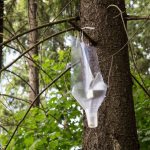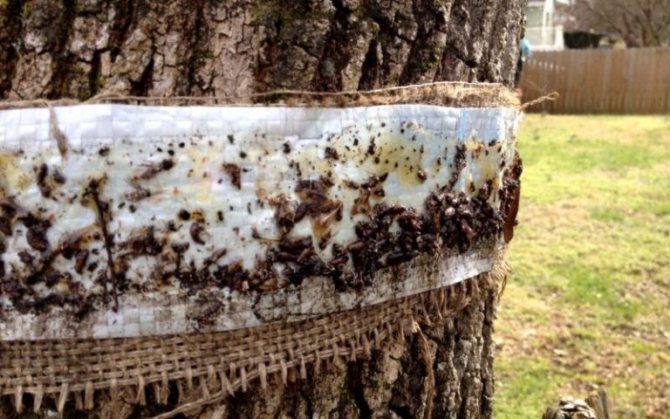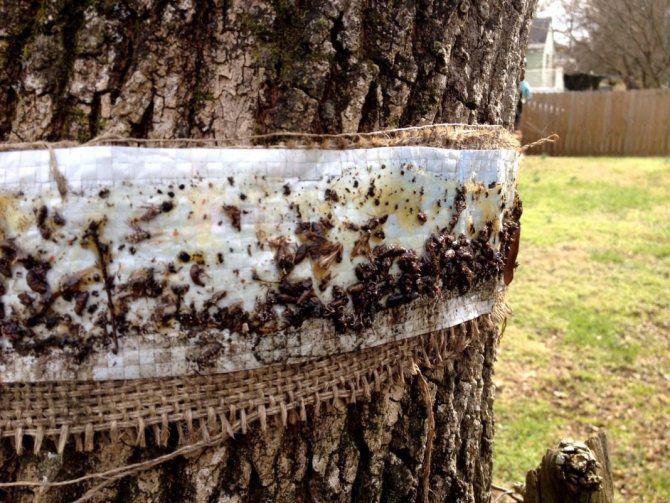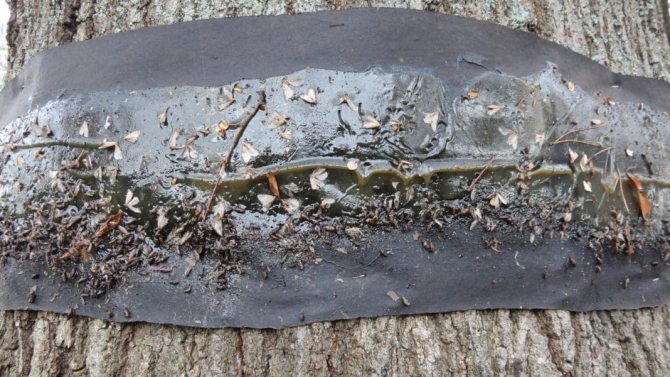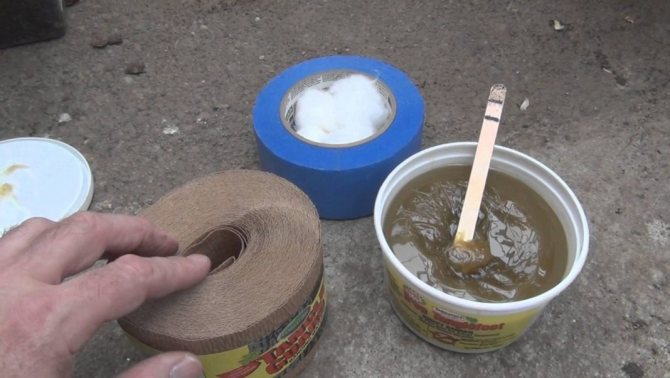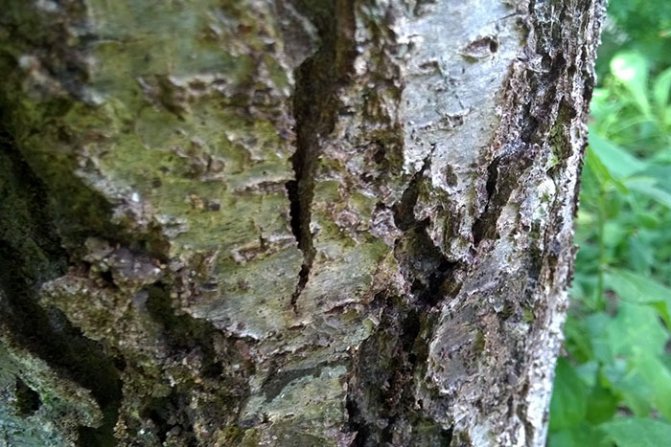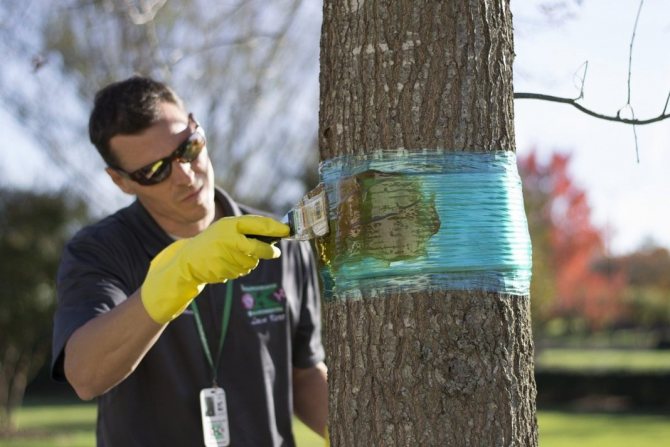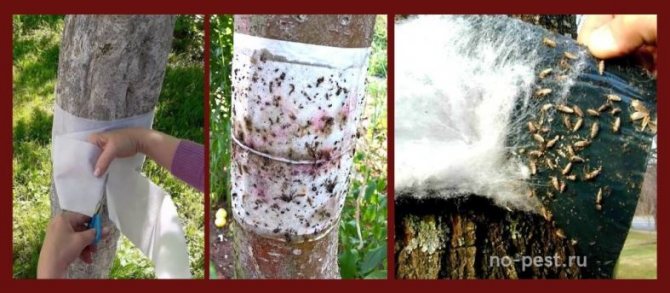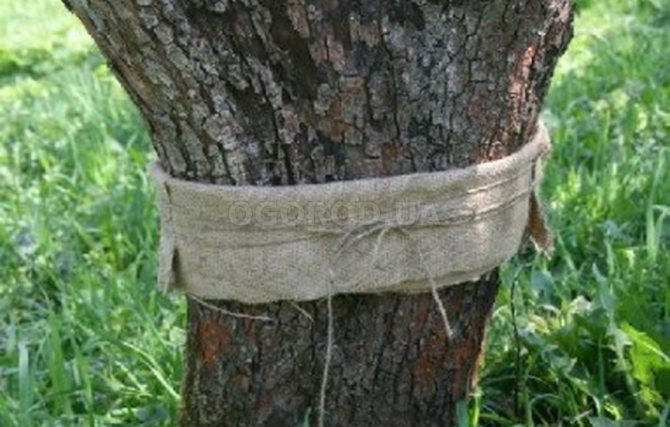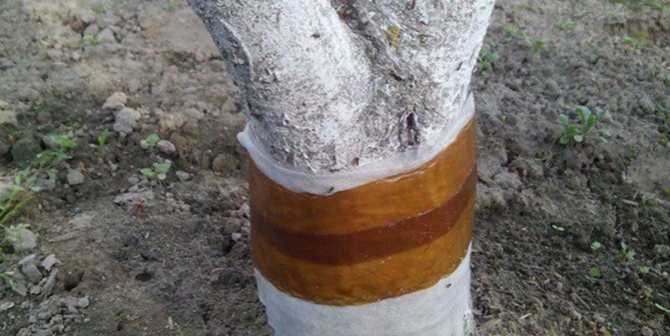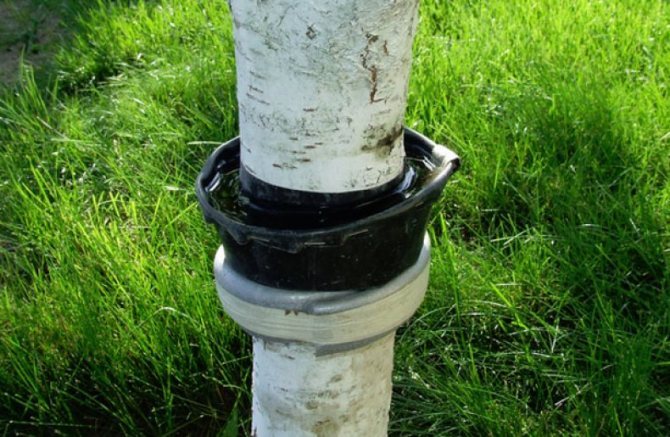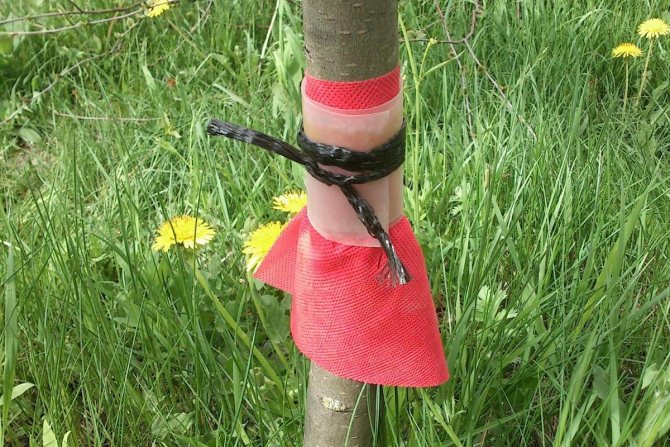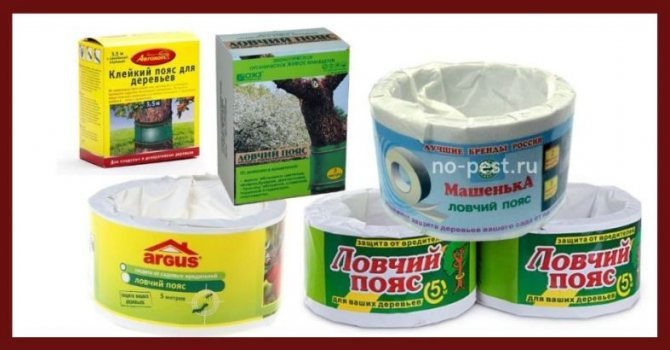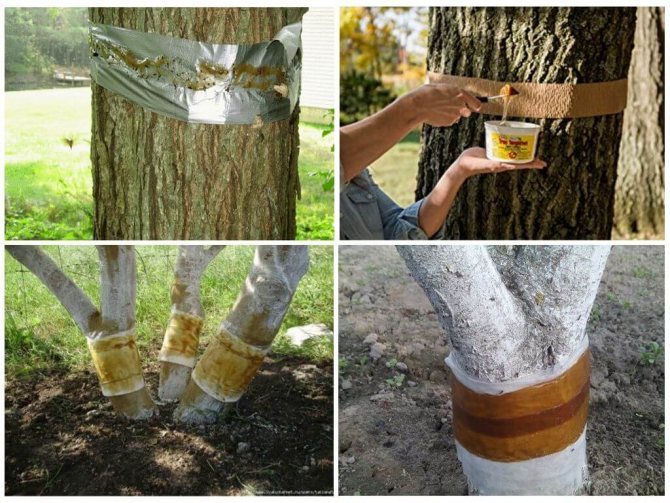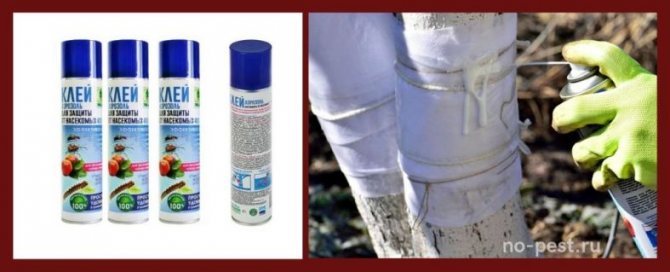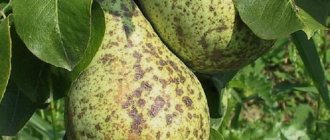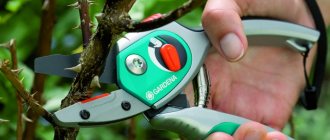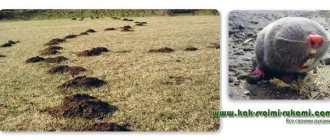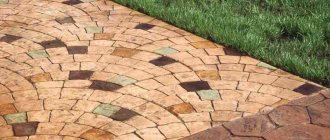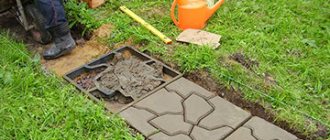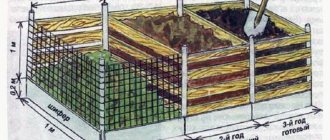The installation of trapping belts on trees from garden pests in spring is included in the complex of services for the protection and care of the garden provided by the Lenotre Park landscape workshop for residents of Moscow and the Moscow region. You can sign a contract for year-round garden maintenance or order separate measures to protect the garden from diseases and pests.
All kinds of flying and crawling insects - butterflies, caterpillars, ants, aphids, larvae - spoil the fruits, ovaries, leaves, bark, wood of fruit trees. Gardeners, amateurs and professionals alike have to construct all kinds of pest traps for trees. Traps can be divided into two types: located in the crown, and trapping belts on tree trunks.
How the trapping belt works
The trap, called by gardeners a trapping belt, is a strip of cardboard, foam rubber or burlap about 25 cm wide.It is wrapped around the trunk of a fruit tree. Small insects moving along the surface of the bark cannot overcome the obstacle, turn back or get stuck inside the strip.
This simple device is effective against aphids and whiteflies, ticks and caterpillars, beetles and brants, garden ants. The hunting belt has several clear advantages over other means of protecting the garden from pests.
- The mechanical method of trapping insects is completely safe for plants and humans.
- The trap is effective against most pests moving along the surface of the bark.
- You can make a fixture of any size, regardless of the diameter of the tree trunk.
- Easy to DIY.
Usually, trapping belts are used to protect single fruit trees in small summer cottages, where it is impractical to use spraying with chemicals. Unfortunately, along with the pests, beneficial insects also fall into the trap, which is the only drawback of the device. Therefore, it is recommended to carefully examine the belt every day and release ladybirds and bees free.
Why is the option good
You can buy a finished product or create a belt yourself, for which you use different materials at hand.
Belts have several advantages over other types of pest control:
- these eco-friendly traps are safe for living things;
- with the help of the device, it is easy to catch many pests.
But there are also some disadvantages when using the device. Sometimes useful insects come across.
Insect traps
Traps are set for wintering insects and those that appear in gardens from spring to autumn. Ideal if you set traps when insects are especially active. For example, in the evening and at night there are much more of them than during the day. Traps protect trees from cherry flies, wasps, moth, scoop, leafworms, silkworms, butterflies, ants.
Pheromone baits
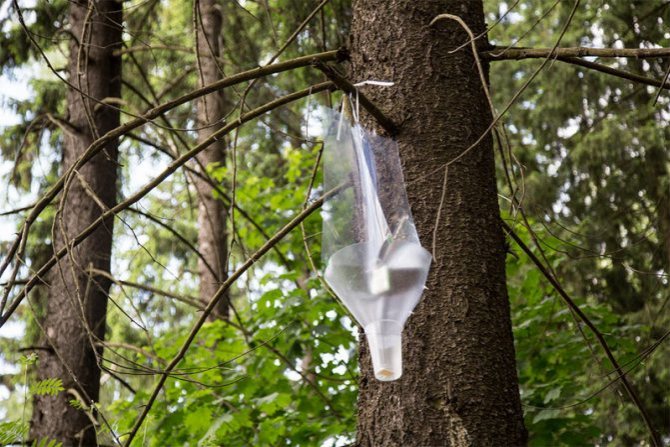
Traps with female pheromones, attracting males from a long distance, give a good result. A small piece of rubber tube is saturated with a solution of sex pheromones and placed in a trap, thickly greased with special non-drying glue. Insects stick and remain trapped.
Pheromone vaporizers attract males with a stronger odor than a real female.It is necessary to hang such evaporators over a large area. This increases the effectiveness of the bait, mating does not occur, and the pests do not have offspring.
Filler traps
Filled traps are containers with bait, falling into which, pests stick or drown, and cannot get out. Insects are especially attracted by the smells of sparkling fruits and brewer's yeast. Jam, beer, compotes are also used as bait.
Plastic bottle traps
It is convenient to make traps from plastic bottles. Such traps are most often used on young trees with a narrow trunk and on skeletal branches.
It should be noted that there are many types of such traps. You can simply make a few small holes at the top of the bottle to spread the scent. But such holes so that small insects can get there. But then the bait itself must be either sticky or toxic to them, so that they cannot fly back when they are full. For larger insects, for example, wasps, hornets, etc., the upper part of the bottle is cut off, pushed down with the neck into the lower part of the bottle, and this structure is fixed with tape on the stem at a height of about 70 cm.The insect, attracted by the smell of the bait, flies into the neck, and here he will not be able to fly back or get out.
Glue sticky traps
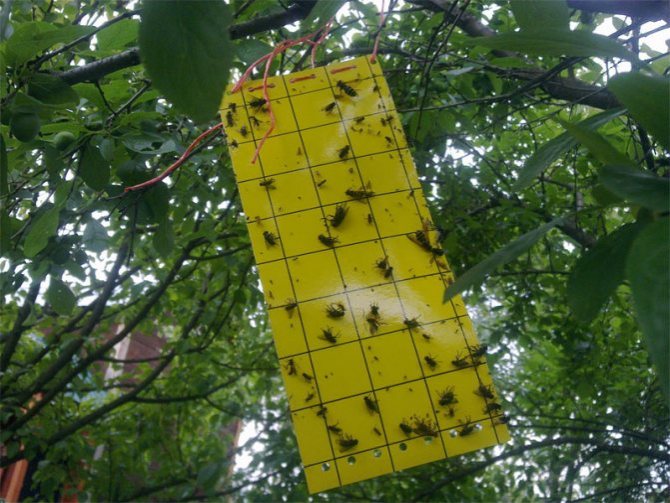

You can buy glue sticky traps at the store. They are rectangular cardboard boxes or yellow plastic greased with special glue. Insects stick to traps at the lightest touch.
A simple sticky trap is easy to make yourself. Bright red or yellow paper is smeared with honey, petroleum jelly, and special glue. A mixture of honey, linseed oil and rosin gives a good result. Hanging on the branches, such traps will collect a lot of insects.
Light traps
Light traps are arranged for flying insects leading an active lifestyle at night. A light guide, lamp or other light source is placed at the bottom of a small open mesh bag. Insects flock and crawl into the light, after which they remain in the bag.
An even more effective light trap comes from a large plastic can. In the lid, the craftsmen make a hole through which they pass the electric cord and attach the base for the energy-saving lamp to it. In the upper third of the can, holes are cut for ventilation, a bait solution is poured inside. It can be kvass, compote, syrup. The principle of operation is the same: insect pests fly into the light and fall into the liquid.
Dry trapping belt
This type of trap is most often found in summer cottages, since it is easy to make it yourself at home. In an hour, you can arrange protection for several garden trees, and without resorting to the use of chemicals at all and without much money. There are several ways to make dry protective tape.
- "Funnel"
This trapping belt for trees looks like a funnel, turned upside down, and serves to catch insects moving along the trunk from the foot to the crown. To prepare the device, you will need a strip of paper or cardboard 20 cm wide, twine, plasticine or clay to smooth out irregularities in the bark.
The trunk at a height of 50 cm is wrapped with paper or cardboard in such a way that the lower edge lags a few millimeters behind the surface of the bark, and the upper, on the contrary, fits snugly. The result should be a skirt-like structure. Insects, falling over the wide edge under the protective strip, get stuck in the layers of paper or come back.
So that the narrow part of the funnel fits as closely as possible to the trunk, cracks and irregularities in the bark in this place can be covered with plasticine, and the entire structure at the top can be screwed with twine.
- "Collar"
A tree hitching belt, made of rubber and resembling a collar, will help protect the plant from pests that descend from the top of the tree to the ground in order to lay offspring and settle for the winter.
To make such a device, it is necessary to wrap a strip of rubber 15-20 cm wide around the barrel at a height of no more than half a meter, glue the sides, and turn the upper edge like a collar. Sunflower oil is poured into the resulting cup. Pests moving down the trunk fall into a viscous oily liquid and die.
The collar belt made of rubber does not strike the eye and does not spoil the appearance of the plant. In addition, it does not have to be reinstalled every year, since as the diameter of the trunk increases, the rubber stretches and only covers the tree more tightly. It will only remain to occasionally add oil and remove the pests that have come across.
- "Hourglass"
A universal hunting belt that is able to protect an apple tree or a pear from the invasion of harmful insects is a device made in the shape of an hourglass. To make it, you need a strip of corrugated paper or cardboard and a strong string.
A paper tape at least 30 cm wide is wrapped around the trunk. Then the middle part is pressed as tightly as possible to the surface of the bark and fastened with twine. The upper and lower cut of the paper strip remains free and protrudes slightly in the form of a skirt.
Before making this hunting belt, the bark at the location of the obstacle must be smeared with clay or plasticine. This is necessary in order to completely close the passages formed due to the unevenness of the surface of the barrel.
Views
There is where to roam, varieties trapping belt has a lot. The most commonly used are dry. They received such love from gardeners, because they are very simple to manufacture and use. These include, for example, funnels.
Most often, with a wide neck, they are directed downward, while the narrow one should be in very tight contact with the trunk. The main thing is that there are no gaps between the belt and the bark, otherwise everything is in vain.
Often, gardeners also make a double-sided design. Those. an hourglass shape is obtained, open top and bottom. So it is possible to catch those pests that descend from above.
And here it is important not to forget about monitoring. After all, all dangerous living creatures will constantly accumulate in such traps, which means that they need to be removed from there and destroyed immediately, preferably on fire. You need to see how things are going at least once a week. And do not forget to make the bandage a little weaker every month, otherwise a groove may form on the barrel.
In order for the bugs to not be able to bypass the barrier, making their way through the holes in the bark, some process the installation site with the belts with garden pitch; clay can serve the same purpose.
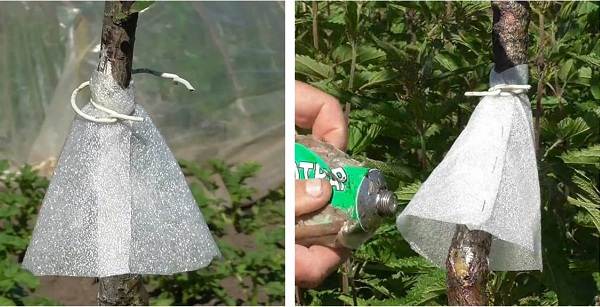

When hunting for a tick, corrugated paper will show itself best. They can be installed not only on the trunk, but also on large branches. And when the gardening season comes to an end, remove all these traps, and send them to the fire, or compost pit.
Also, among the dry options, very unusual structures made of foam rubber, or even glass wool, simply wrapped around the plant were noticed. If you look at such hunting belt pictured in an enlarged form, one can understand that it is like a labyrinth for insects, from which they have not the slightest chance to get out.
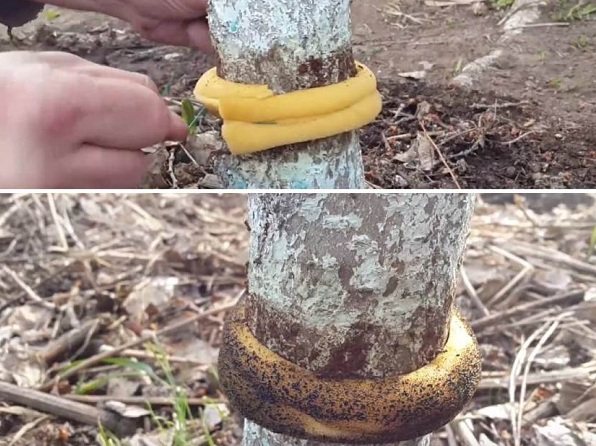

Quite simple, no less reliable - a trap from a plastic bottle. We are sure that everyone has an overflowing container, which is a pity to throw away, and there seems to be nowhere to use. So, take this, cut off the bottom.
The resulting workpiece must be cut vertically. Then wrap it around the trunk. If it is wide enough, it is worth taking two bottles and joining them together. The wider part of the container should point downwards.
And the narrow one should be properly fixed, for these purposes you can take scotch tape.Like paper, this design can be made double-sided. Then the funnels will look up and down, isolating the insects coming from both sides. Small longitudinal cuts on the neck will help to install the structure more carefully.
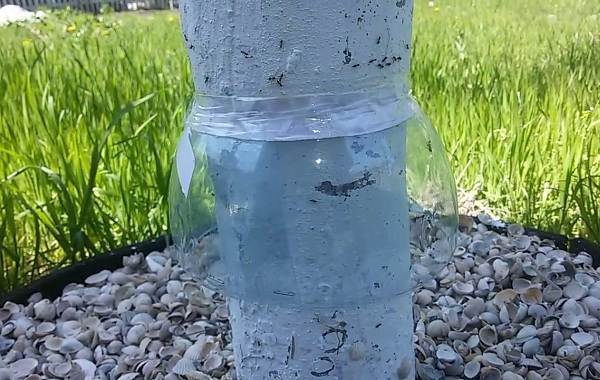

The collar belt is also referred to the same subspecies. True, his duties include keeping only descending insects. This trap looks like a bowl bordering the barrel.
It is made of rubber, and therefore it is believed that the tree will be most comfortable in such a "skirt". After all, this material is able to stretch, adjusting to the growth and metamorphosis of the plant. And inside this bowl there should be a liquid, most often oil is chosen for this purpose.
Poisonous apple tree trapping belt fits the most. Do not be intimidated by such a name. All chemicals that will be used in this case will not penetrate either the fruits, or the green part of the crown, or the root system.
After all, such an effect is made with the help of an impregnated fabric that is attached to the tree. The very poisons are used as a moisturizer. But in this case, they act only on the pest, saturating its respiratory system with dangerous vapors.
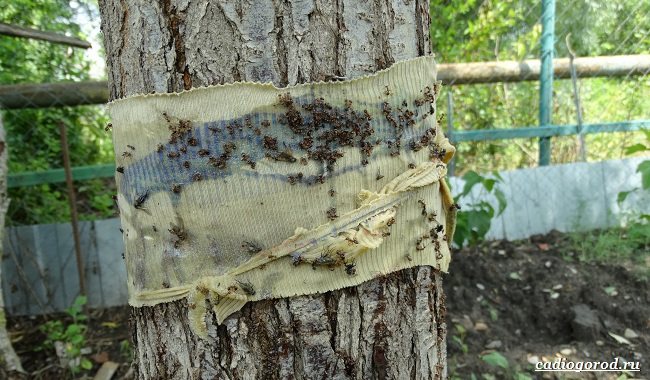

And the third design option is fly sticks. The same principle works here as when catching flies with sticky tape. If you are looking for ant trapping beltthen this one will be the most suitable. By the way, these insects are the most agile.
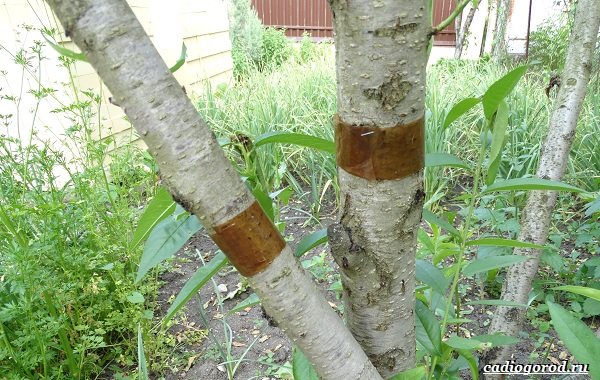

They manage to bypass other barriers. This is especially easy for them if the plant is already a middle-aged tree with ideally even and smooth bark. But why should they make their way to the tree crowns? As it turns out, the creatures themselves are not dangerous at all.
They are simply "transport" for aphids. Since aphids provide them with food, ants constantly transfer dangerous pests to the leaves of trees so that they can eat. And such snacks, especially for young plants, can be destructive.
If you cannot decide which type is most suitable for your purposes, just combine two different types at once. For example, regular dry and sticky. It will not get any worse from this, the main thing is to remove everything in time and monitor the state of the traps.
Why is it needed
Of course, it does not protect from all bugs unwanted by a person garden hunting belt... But the list of those whose invasion he is able to cope with is quite good. As a rule, we are talking about insects that breed in the earthen flooring, and march in rows along the trunk to the leaves and fruits for feeding.
All kinds of caterpillars will not pass to the goal, it will be difficult for ticks and aphids to get to food. Apple flower beetles will also face problems on the way to the goal, like weevils, geese, moths.
Flower beetles are dangerous because if they get on the buds, you will not see the harvest, because these creatures destroy the inflorescences from the inside, not allowing them to develop. No less dangerous is such an animal as the bark beetle. You may not immediately notice it, all because this bug makes its moves in the tissues of the tree under the bark. As a result, the plant is sick, and may even die completely.
Poisonous Trapping Belt
In addition to traps of mechanical action, there are poisonous trapping belts, falling into which, insects die from the insecticide. Despite the high effectiveness of such protection, gardeners are reluctant to install poisonous belts on fruit trees, fearing the penetration of a chemical into the fruit. However, experts have proven that these fears are unfounded. After all, the trap is located much higher than the level of the root system, and the nutrients into the crown of the tree come from the root. Most often, devices with an insecticide are installed on apple trees from ants and caterpillars that rise from the ground to the crown.
To make a poisonous hunting belt, you need to moisten a strip of burlap or ordinary material 25 cm wide in an insecticide solution and fasten it tightly on the trunk in the form of a skirt.
Important!
To prevent the poisonous liquid from evaporating longer, the entire structure can be placed under a plastic bag, leaving the bottom edge free.
Once in such a trap, the insect will die, suffocating from the poisonous fumes. The duration of the trap is from one to two months, after which the material inside must be again impregnated with the chemical.
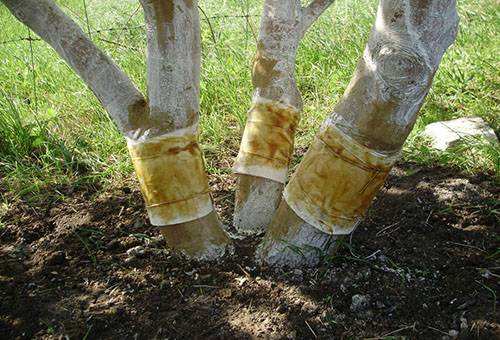

What is a trapping belt and what is it made of
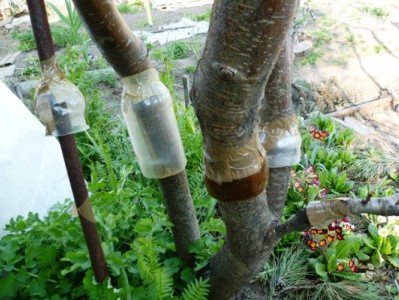

The classic hunting belt is a narrow strip that encircles the trunk of an adult or the trunk of a young tree. Its design is such that insect pests cannot climb into the crown of a garden plant. A properly made and secured tree trapping belt provides better protection than chemicals. It helps to eliminate the problem of the infestation of the following insects:
- caterpillars of apple, pear and plum moth;
- geese;
- cherry and gray kidney moths;
- apple and other flower beetles.
Belts are made from simple materials, many of which are classified as household waste. Pieces of rags, burlap, straw, scraps of tow, glass wool and corrugated cardboard are suitable for this. Recently, rubber sheets, plastic opaque films, and plastic containers from carbonated drinks have been popular. Trapping belts are fastened 20-40 cm from the soil surface on a tree trunk. As insects fill, they are cleaned by hand, or removed and destroyed completely.
Ant Gate Trap
Making a collar belt is as easy as making a funnel. The trap remains almost invisible on the trunk and, moreover, it is able to "transform" along with the tree. How to make a gate-shaped ant trapping belt - detailed instructions:
- Cut a 4-5mm thick rubber band and measure about half a meter from ground level.
- Fold back the edges and fasten the tape to the trunk - you get a kind of "collar". Then glue the ends of the strip with glue.
- Add sunflower oil to the resulting sealed container. Pests caught in the container will not be able to get out of it and continue downward.
- The resulting elastic trap from ants and other insects will grow with the tree. It can last a long time, the most important thing is to remove the insects that have got into it in time and add vegetable oil.
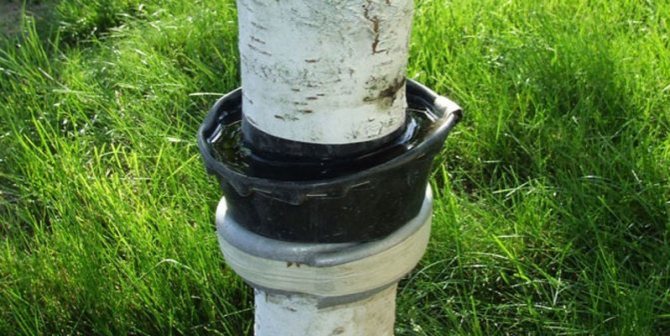

Sticky Trapping Belt
As the name implies, this type of trap implies the presence of a sticky layer. It is not difficult to build such trapping belts with your own hands, you just need to purchase it in the store or prepare yourself a suitable adhesive composition.
Usually glue belts are used in combination with dry or poison traps, but sometimes they do a good job on their own.
The manufacturing process of the device is as follows:
- cut out a strip of corrugated paper, the width of which is at least 20 cm, and the length should be enough to wrap around the trunk;
- one side is thickly smeared with glue;
- fix the tape with the sticky side up 50 cm from the foot of the tree;
- below and above the belt, the passages are covered with clay.
You can make glue for catching caterpillars and stalks yourself at home. To do this, combine vegetable oil, taken in an amount of 200 g, 100 g of wax and the same amount of grease, mix all the components thoroughly and warm up. The resulting mixture is used as a sticky layer in trapping belts.
The sticky belt on fruit trees is the safest and most effective defense against harmful insects.
How to make
To make DIY trapping belt - not the most difficult task. For the dry version in the form of a funnel, you need paper (keep in mind, this is not the most practical option, because the device will instantly get wet at the first precipitation, which means it will lose its protective properties, the same applies to cardboard, albeit rather dense), fabric, burlap, which whatever,from which you can build a cone.
The strip of material should be no thinner than two tens of centimeters. Form a funnel and attach to the tree with the wide side down. And the upper end must be tied with twine. Some insure themselves and cover the upper end with plasticine. That's it, the trap is ready. It turns out that insects, trying to climb up the trunk, get stuck along the way in this funnel.
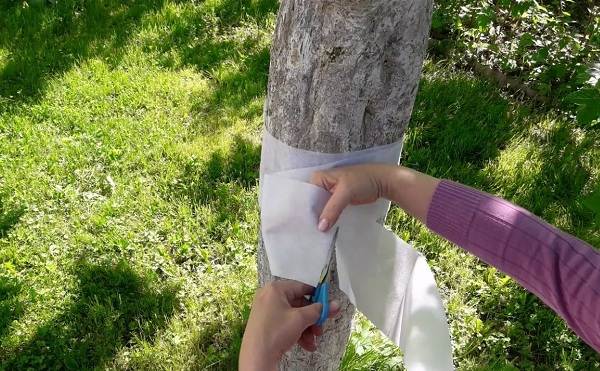

If the question is: how to make a trapping belt rubber, then just take a piece (five centimeters will be enough, but you can use a wider cut), wrap it around the trunk, and glue the ends.
Then turn some of the fabric outward so that you get a bowl. Pour ordinary sunflower oil into this container. That's it, the insect killer bath is ready. True, the filler for such a trap needs to be changed periodically.
A wet poisonous belt should be made from burlap, or something similar. The width is standard, all the same twenty centimeters. Wet them abundantly with chemicals and build the funnel-shaped structure again. It can still be covered with a film, otherwise the insecticide will quickly disappear, and the desired result will not be.
For a sticky trap, you need strong enough paper, burlap, or thin foam rubber. Some have adapted baking paper for these purposes, and the substrate under the laminate has also shown itself well. Selected glue trapping belt should cover completely, without any gaps.
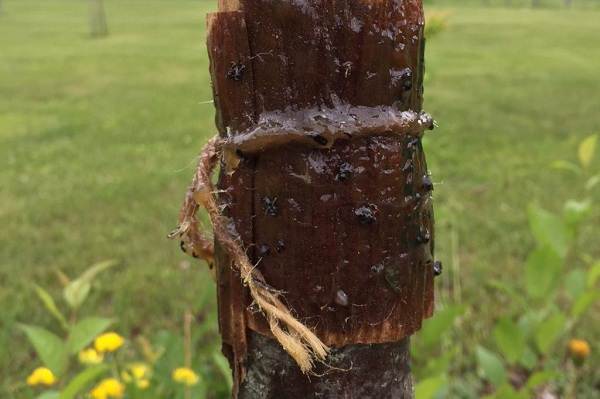

But whatever is not suitable, you need one that does not lose its sticky properties for a long time, because it is thanks to this property that the barrier will prevent the passage of insects. In addition, make sure that there are no different toxic substances in its composition. If suddenly such an option was not found in the store, it is quite possible to take a sticky mass from rodents.
It meets all of the above requirements. For these purposes, you can still take resin, some use tar. If you come across such a "specialized" glue on the counter of a supermarket, and the seller assures you that it can be applied directly to the bark without fear for its integrity, this is not true.
Any composition will harm the "woody skin", therefore the use of a substrate is a mandatory item. The layer of binder should be renewed at least once a month. And attach the fabric itself with a string. If it suddenly turned out to be a rainy summer, you need to check the "occupancy" of such a trap more often than usual. Update it every couple of weeks.
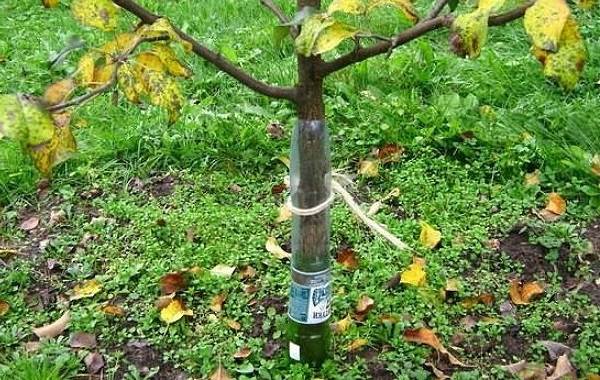

There are also recipes on the Internet for making a sticky mass with your own hands. To do this, you need to take almost equal amounts of rosin and petroleum jelly, and ten times more pine resin.
It is also possible to make a semblance of such a trap with the help of a means for processing animals infected with parasites - creolin. It is easy to find at any veterinary store. Take two milliliters of the product and add to half a liter of vegetable oil.
Do not forget to mix it all very thoroughly. After that, you need to apply the composition to the bark, not very high, about thirty centimeters from the ground. This will give you a two-in-one product. After all, the frozen mass will have a deterrent effect and work like glue.
The most advanced option is a sticky spray. This is for those who want to do everything without getting their hands dirty. It all starts with the same scheme as with other types of glue - the base is attached. Then spray the composition on it.
It fits very thinly, which means it will be spent sparingly. And if you have an unnecessary mass, you can always use it at home, as a remedy for annoying flies and mosquitoes, placing traps in the form of ribbons covered with the composition.


These traps are set, as a rule, at a distance of half a meter from the ground. But this may be an indicator of thirty centimeters, it all depends on the size of the plant, the main thing is that the trap is below the crown.
It is worth remembering that before attaching the trap, it is supposed to carry out preparatory work.Namely, to shave off the old, dried bark from the tree. But do it carefully so as not to harm the top layer of the trunk. It is better not to use iron tools for such purposes. Brushes and a rough cloth will work.
It is best not to reuse the product. If you have the ability and strength, build a new device each time. Extra costs it does not require. You need to remove the trap immediately after the fruits from the trees have already been collected.
But only not in the case when we are talking about apple trees, or pears. After all, insects often settle on them, which in the fall begin to crawl to the ground to shelter there. Therefore, you have the opportunity to block them, leaving the trap until October.
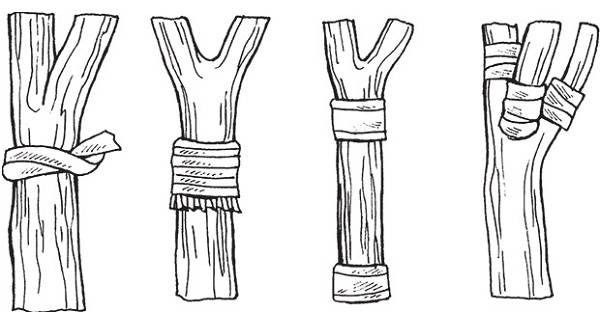

Price of ready-made belts
Since not everyone wants to bother and sculpt something there, and mix it on their own, finished products appeared in household hypermarkets a long time ago. This can be a duct tape-like belt, similar to wide scotch tape.
A product of small length, up to a meter, can be bought for one hundred, one hundred and twenty rubles. If you have a rather large, adult tree in your garden, and you need a longer ribbon, you will have to pay an amount of five hundred rubles.
There are also specials. adhesives, they are inexpensive, about a hundred rubles per tube. For a set of specials. the backing material and adhesive will have to pay about two hundred rubles. Quite affordable products for every gardener.
How and when to install the belt
The best time to install trapping belts is considered early spring, when the buds have not yet awakened, and the harmful insects that hibernated in the soil have not reached the surface of the earth and have not gone to the crown.
You can remove traps from cherries, apricots, peaches and plums immediately after harvesting the fruits, but it is recommended to leave protective devices on apple trees until mid-autumn or not remove them at all. This will save next year's harvest from the moth, which lays eggs in the fall.
Usually the trap is located at a height of half a meter from the ground. The main thing is that the belt goes below the crown. It is necessary to check the protective devices and shake out the trapped insects as often as possible, and preferably every day. Live pests must be destroyed.
The technique of using trapping belts for the bases of tree boles
The belt is placed on the trunk, retreating from the ground by 0.5-1.5 meters. In any case, it should not reach the crown.
It is recommended to inspect and shake out pests every day by spreading a polyethylene film under the tree.
Otherwise, insects can get out of the trap. Falling pests are necessary
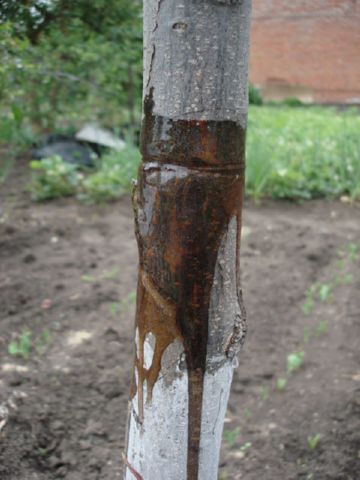

immediately destroy, except for pupae, moths. They should be placed in a glass jar and covered with a net. In such a simple way, the time of departure of butterflies is determined in order to take timely measures to destroy them.
It is best to attach the belts before the buds awaken, so as not to miss the exit of pests hiding under the ground. Remove traps from stone fruit trees after harvesting. On apple trees, it is better to leave belts until late autumn, removing them at the end of October. So you will not allow the winter moth on the trees, which lays eggs in the trees before winter and settles there for the winter.
Fishing belts can be made independently or purchased ready-made. Currently, there are many options offered by various manufacturers. Fishing belts differ in composition and cost. It will not be difficult to choose a product to your taste and wallet.
Sandy sludge is one of the worst pests of sunflower. Melilot is an excellent melliferous and fodder plant that is often attacked by pests. Which of the insects feeds on this grass, you will find out here.
The hemp flea not only feeds on hemp, but also includes hops and nettles.
Belts from firms
It is a five meter long tape made of thin plastic film. She is covered
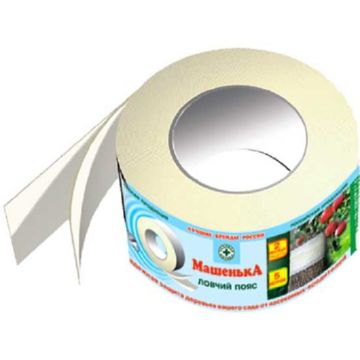

adhesive insecticidal preparation on the outside and inside. It does not dry out and does not lose its properties during the entire spring-summer season. Equally firmly attached to the smooth trunk of a young tree and to the old rough bark. Does not undergo deformation, does not deteriorate from precipitation.
The manufacturer recommends using a fishing belt between March and October. The method of application is very simple. A strip of the required length is cut from the roll and wrapped around the barrel. Trees should be whitewashed before using the belt to protect the bark from sudden temperature changes typical of the early spring period.
Silvalur glue band flexi
Trap from Sweden. The kit includes a 5-meter long tape with foam gaskets and fasteners in the form of locks. Waterproof, long-term non-drying barrier against insect pests.
Foam inserts allow the belt to fit snugly against the trunk, and the locks make it easier to secure the belt to the tree.
"Argus"
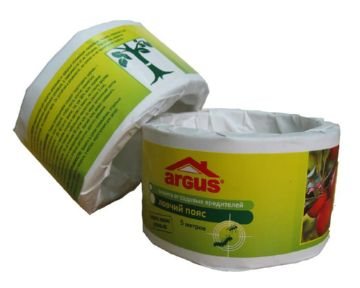

A tape 5 meters long, rolled into a roll. The outer side is treated with glue that is resistant to high humidity and does not dry out for a long time - up to 60 days.
It is an environmentally friendly non-toxic mechanical tool for catching caterpillars. Before using the belt, the trunk of the tree is preliminarily cleaned of dead bark, making it smooth. Placed at a height of 70-80 cm from the ground.
"Trap"
The carton contains 2 belts, each 75 cm long. This amount is enough to protect 3-6 trees. The belt is a laminated paper covered with non-drying waterproof glue.
It can be used before the buds open to trap pests hiding in the ground for wintering; in summer - for the destruction of ants, caterpillars and larvae; in August-September - for catching moths.
The ease of use of the belt is combined with excellent quality and low cost.
Work order
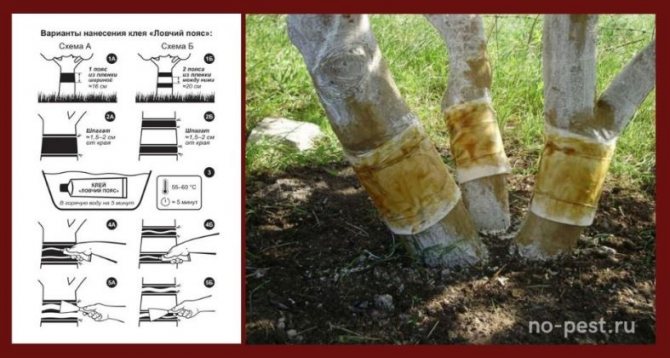

- To prepare the bark of the tree - remove dead and dry bark with a spatula or brush with iron bristles.
- At a height of 30-80 cm from the ground, wrap the tree with strips of bandage, polyethylene or fabric, 10-12 cm wide. in several turns. It is better to use non-woven fabric, it is not subject to decay, because dries quickly after rain and tree bark does not melt. The total width of the belt should not exceed 20cm.
- It is allowed to make a double belt - from 2 strips, at a distance of 20 cm from each other.
- Tightly fix the future hunting belt with twine in 2 places - above and below the belt, retreating 1.5-2 cm from the edges. It is better to use polypropylene twine.
- Apply glue. The glue from the tube is applied in several girdling rims. Since the glue is very viscous, it is better to slightly heat the tube (50-60 degrees) for even application of the glue. Spread the adhesive evenly with a spatula. If aerosol adhesive is used, the width of the adhesive strip is about 10 cm.
- When using ready-made glue strips with already applied adhesive, it is necessary to wrap the tree with a belt with a slight overlap of about 3 cm, sticky side out. For better fixation, it can also be additionally tied and tightened with twine.
- For a snug fit of the fishing belts, I can recommend using a foam rubber backing, or better polystyrene foam.
- After 60 days, you can renew the belts, although this is not necessary, the belt can remain functional throughout the season. Usually, the belts are renewed if they are completely covered with insects.
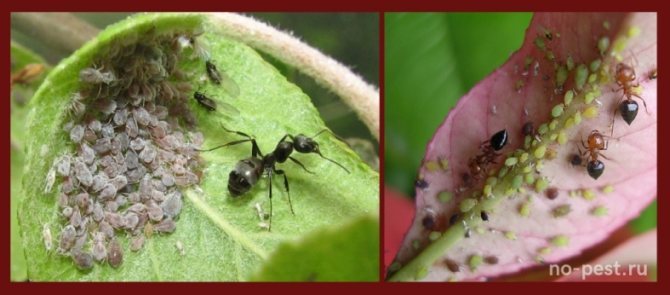

What are insect belts?
Adhesive trapping belts
The belt is applied to the wood with a special glue
The hunting belt is applied to the bark of the tree with a girdling rim with a special especially sticky and viscous glue against insects and rodents. This glue is produced in tubes - the trademarks "Clean House", "ALT", "Napoval", "Domovoy", "EUROGARD", "ECOTRAP", "ARGUS", etc.
The glue is made on a polymer basis, which includes:
- polyisobutylene (chemically inactive polymer component that provides moisture resistance);
- polybutylene (providing viscosity, thermoplasticity and fire resistance);
- cycloisane (acting as a catalyst - enhances the effect of the adhesive).
Belt in the form of ready-made glue strips
Ready-made trapping belts are also produced - these are strips of fabric or non-woven material with an adhesive applied. Trade marks "Your economy", "No-guest", "ARGUS", "Kapkan", "Inta-Vir", etc.
Adhesive spray
Special garden glue-aerosol is represented by the Green Belt trademark - a 400 ml balloon. You can, in principle, use any universal adhesive in aerosol form.
The main advantage of the aerosol is uniform and economical atomization. There is enough glue in the balloon to make more than ten fishing belts. The long shelf life will allow the aerosol to be used for more than one year.
Protective oil belts
Ants do not like to overcome oil barriers. The belt is made of vegetable oil on a palm-wide tree (10-12cm). You can use any vegetable oil - sunflower, linseed, hemp, or others. Furnace soot can be added to the oil.
It is allowed to alternate glue strips with oil strips - it turns out, the so-called "double protection".
"Scarer" belts
You can make independent and "deterrent" belts. To do this, the tree trunks are tied with strips of cloth dipped in kerosene, diesel fuel or carbolic solution. After 2-3 weeks, it is necessary to re-soak the fabric with kerosene.
This method is not recommended for young trees to avoid scalding. In this case, you can knead a cloth soaked in kerosene or diesel fuel at the base of the tree. The pungent smell will completely scare away insects.
Danger of ants
For fruit trees, ants are not directly pests. They do not damage the integrity of the tree during development. And after the tree has grown completely, they will not be able to harm it.
However, the harm to fruit trees from ants is different. These insects are the main distributors of aphids - very dangerous pests that feed on nutrients from plant leaves. The secretions of aphids are food for ants, so they protect them and regularly feed them on the leaves of trees. Aphids can cause irreparable harm to young trees.
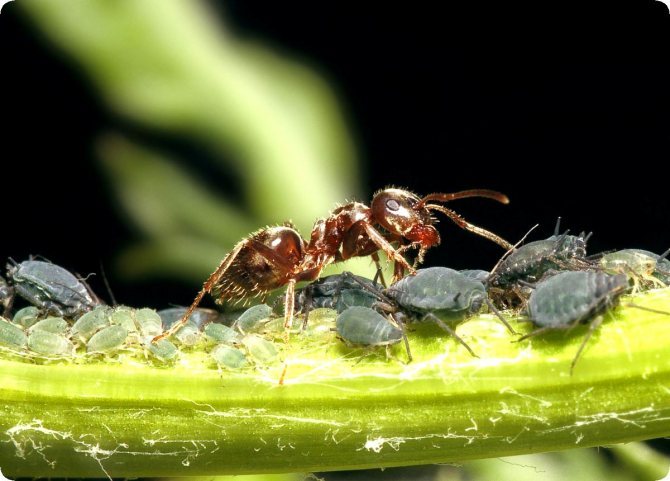

Since ants live in the garden mainly in underground anthills, aphids can be delivered to a tree only along the trunk of the tree. Therefore, the most effective tactics for fighting ants on trees have been and remain trapping belts. Also, this device helps to get rid of other pests traveling along the tree trunk.
How to prepare a tree trunk
Before starting the manufacture of the fishing belt, we will properly prepare the tree trunk for this event.
Attention! Preparing the base of the tree for the installation of a trapping belt is an action that directly affects the effectiveness of the entire ant control measure.
Preparing a tree trunk for setting up a trap requires one important rule to be followed. At the installation site of the belt, it is necessary to carefully cover up all cracks in the bark, especially when processing old plantings. As a putty material, you can use:
- clay + sawdust;
- plasticine, etc.
If this rule is not followed, then insects will easily bypass the established barriers through cracks, and all pest control measures taken will be useless.
What is a trap
Not wanting to "feed" the garden with chemistry, many summer residents are fighting ants with folk remedies and inventions. Making ant traps on trees with your own hands is a snap. Here are several options for such designs.
Tire trap
Every motorist has old car tires. Of these, it is very easy to build a pool, which the pests will not be able to swim across.It is enough to cut the tire along the center to get a pair of separate rings.
A ditch should be dug around the ant-infested tree or bush, the diameter of which will correspond to the cut ring. A tire is put on a tree trunk through the crown, and the container is filled with water. Such a water barrier will reliably protect the plantation from pests.
On a note!
If the crown of the tree is too large, then the rubber ring must be cut and installed in a similar way. To seal the joint, use scotch tape or plasticine.
Scotch trap
To get rid of ants in trees, you can make another insect trap. All you need is scotch tape. Sticky tape is wound around the trees like a belt. Remove the protective film from above. Such a simple structure will serve as a good barrier to ants.
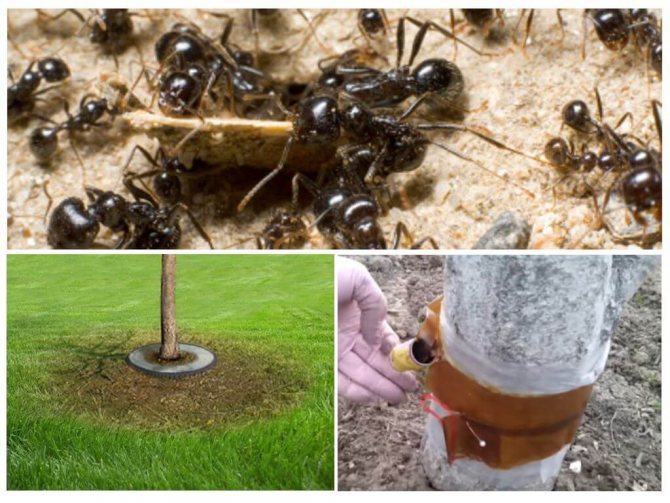

Ant Traps in Trees When using single-sided tape, it is wrapped around the trunk with the sticky side up. Having reached the sticky belt, the legs of the crawling insects will get bogged down in it. The same ants that manage to escape from the "captivity" will leave this tree forever.

